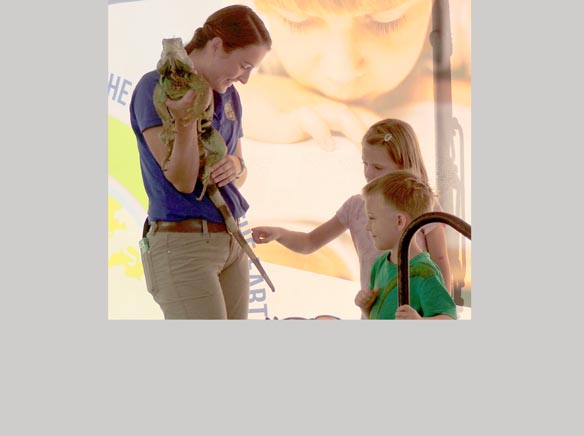If there’s one way to get kids to learn, it is bringing in animals. The kids visiting the Creation and Earth History Museum on Creation Day Family Festival on Nov. 5 had the opportunity to do just that.
“We’re going to a see a lot of awesome creatures today, many of them you’ve never seen before, I’m sure,” announced Nathan Hutcherson to a crowd of kids under the Main Stage tent.
If there’s one way to get kids to learn, it is bringing in animals. The kids visiting the Creation and Earth History Museum on Creation Day Family Festival on Nov. 5 had the opportunity to do just that.
“We’re going to a see a lot of awesome creatures today, many of them you’ve never seen before, I’m sure,” announced Nathan Hutcherson to a crowd of kids under the Main Stage tent.
“We believe that the purpose of animal life is to glorify its Creator,” Hutcherson said.
Hutcherson introduced Michelle Engler of Wild Wonders, who led a veritable parade of unusual critters, beginning with the hyrax manatee, a hairy rodent-like animal.
“I know he looks like a rodent, but he’s actually in the same family as elephants,” Hutcherson said.
The kids all laughed and stood in line for their chance to touch the animal.
Next up was a kinkajou, another rodent-like creature, which was hanging b its tail from Engler’s hand.
“Okay, this guy grabs things with his tail, he eats upside down, he is solitary and nocturnal. What does nocturnal mean?” Hutcherson asked his audience.
“He’s awake at night,” came the answer in unison.
A chorus of giggles rose up under the tent when Engler came out holding in her hand a fat little creature.
“This is a Screaming Hairy Armadillo,” Hutcherson said. “He actually does make a little screaming sound. And can you see the hairs protruding from his body? He has a very poor sense of eyesight, but strong smell and he eats mice and rats.
Engler brought out several reptiles for the kids to admire. Their favorite was a giant green iguana.
“This guy is actually a rescue animal. Iguanas have been really popular as pets in recent years, but to tell you the truth, they can be very difficult to take care of. They can’t make their own Vitamin d in their bodies like we can. They can easily get sick,” Hutcherson said.
Hutcherson ended the animal show-and-tell by explaining that evolutionists teach that everything began from a simple organism. On the other hand, using both the Holy Bible and scientific evidence, creationists believe that each animal can change or evolve over a period of time, but not come from the same, simple organism.
The petting zoo was a favorite stopping-off point for the children before they went to the auditorium for Super Science, presented by Mark Finkbeiner, who is the founder of Mark’s Academy of Science.
Finkbeiner had set up the stage in front of the auditorium with all sorts of experiments. “Did you u know that science often tests things that cannot be seen? A lot of people say that if you can’t see something, then its existence cannot be proven. Yet science does this all the time.”
Finkbeiner held up a flask, showing the audience that it was empty inside. He then soaked a cotton ball with alcohol, lit it on fire and dropped it into the flask, causing the flames to extinguish.
“The hot air in the flask from the cotton ball rose, causing less air pressure,” Finkbeiner explained.
He placed an egg in the mouth of the flask and everybody burst out laughing when the egg dropped to the bottom.
“That’s air pressure at work. But you can’t see air pressure, can you? But does that mean that it does not exist? Of course not. Same thing with proving the existence of God. You can see what He has done by just looking outside and seeing a tree. We can’t see Him, but we can see what He has done.”
“Doing science experiments is so much fun because they lead back to God as the creator of the universe, not a cosmic burp or accident,” Finkbeiner said.
Finkbeiner did several more experiments, some with lights and magnets and even some balloons exploding. After his science show was over, people of all ages left with smiles and things to talk about for the afternoon.
The Creation and Earth History Museum opened in 1992 under Dr. Henry Morris’s Institute for Creation Research. When the Institute moved to Texas in 2008, the entire museum and its contents were sold to Scantibodies Laboratory, Inc.
Tom Cantor, the owner of Scantibodies Laboratory, Inc., and his wife Cheryl founded a non-profit 501c3 ministry called the Light and Life Foundation. The Light and Life Foundation owns and operates the museum, dedicated to the biblical account of science and history.
Facilities include a 10,000 square foot showcase for a literal six-day creation and young earth, including a human anatomy exhibit, life-size tabernacle display, age of the earth cave and more.
The museum is open seven days a week at 10946 Woodside Avenue North in Santee. Call 619-599-1104 for more information.














